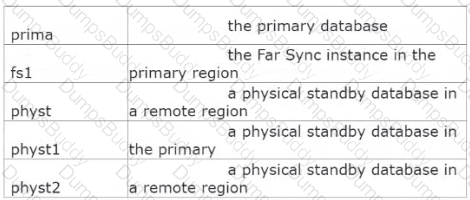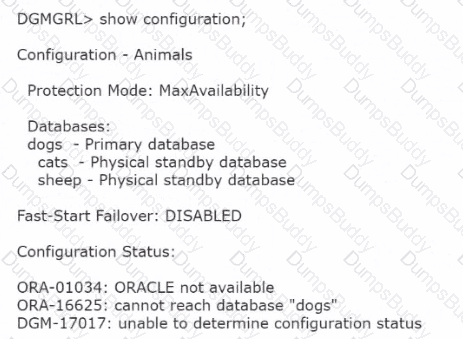Your Data Guard environment consists of these components and settings:
A primary database supporting an OLTP workload
A remote physical standby database
Real-time query is enabled
The redo transport mode is set to SYNC
The protection mode is set to Maximum Availability
Which two statements are true regarding the DelayMins database property for the standby database?
You created the PRODSBY1 physical standby database for the PROD primary database using gql and RMAN. You are planning to create a Data Guard Broker configuration. You execute the command:

Which three statements are true regarding the execution of the command?
A Data Guard environment has this configuration and these attributes:
The primary database prima is in the local region.
A physical standby database physt1 is in the local region.
A physical standby database physt2 is in a remote region.
The primary ships redo to physt1.
physt1 ships redo to physt2.
physt1 and physt2 have Real-Time Query enabled.
A sequence has been created with this SQL statement in the primary database:
CREATE SEQUENCE a NOCACHE SESSION;
Which TWO statements are TRUE?
Active Data Guard (ADG) databases are widely used to offload reporting or ad hoc query-only jobs from the primary database. Reporting workload profile is different from the primary database and often requires tuning.
Which tool is used to tune SQL workloads running on an ADG database?
Suppose that you manage the following databases in your environment:
• boston: Primary database with a single PDB called DEVI
• london: Physical standby database protecting the PDB called DEVI
• orcl: Stand-alone database with a single PDB called PDB1 as a remote clone source
You are planning to run the following command to create a remote clone in the primary database (boston) using pdbi in orcl:
Which are the THREE prerequisites for automating instantiation of the PDB in the standby database (london)?
In Oracle Database 19c, you can set the value of database initialization parameters in a database using
the EDIT DATABASE... SET PARAMETER Command:
DGMGRL> EDIT DATABASE 'boston' SET PARAMETER log_archive_trace - 1;
Which THREE statements are TRUE about the command?
Which two are true concerning the configuring of Flashback database in a Data Guard environment?
A customer has these requirements for their proposed Data Guard implementation:
1. Zero data loss must still be guaranteed through the loss of any one configuration component.
2. The primary database must be protected against a regional disaster.
3. Performance overheads on the primary should be minimized as much as possible given these requirements.
4. Downtime on the primary database for any reason must be kept to a minimum.
Components referred to in the broker commands are:

A)

B)

C)

D)

Which THREE are true about using flashback database in a Data Guard environment?
There are currently 6 applief. and 6 pfepafef processes running and no idle applier processes on y logical standby database.
The max_SERVERS SQL apply parameter and number of archiver processes are both set to 12.
Identify two changes, each of which would allow you to increase the number of applier processes.
Which two are true about managing and monitoring Oracle container databases in a Data Guard environment using the broker?
Examine the Data Guard configuration:

Which three will be true after a successful failover to Cats?
You have a Data Guard broker configuration consisting of:
A primary database
One local physical standby database
One far sync instance
A remote physical standby database
The broker configuration was created with the DGMGRL utility after creating all the databases and the far sync instance with command-line tools.
What is the correct way to add this configuration to Enterprise Manager Cloud Control assuming all the nodes have been discovered already as Enterprise Manager targets?
Which three are true about using Flashback database through role transitions in a Data Guard environment?
Examine the procedure that you plan to execute on your logical standby:
SQL> EXECUTE DBMS_LOGSTDBY.SKIP(stmt => 'DML', schema_name => 'HR', object_name => 'EMPLOYEE');
What is a prerequisite for execution of this procedure?
You detected an unrecoverable archive gap in your data guard environment. So, you need to roll standby.
forward in time without applying a large number of archive log files using this command:
RMAN> RECOVER STANDBY DATABASE FROM SERVICE-
When running this command, which of the following steps can be performed automatically?
1. Remember all data file names on the standby.
2. Restart standby in nomount.
3. Restore controlfile from primary.
4. Mount standby database.
5. Rename data files from stored standby names.
6. Restore new data files to new names.
7. Recover standby.
You must configure flashback database for your Oracle 19c databases that will be part of a Data Guard Broker configuration.
The databases are all in ARCHIVELOG mode.
You will execute the SQL statement:
ALTER DATABASE FLASHBACK ON;
Which three are true concerning this command?
On your logical standby database, you specified these rules:

After completion of the weekend batch cycle you attempt to delete the SQL Apply filters:

Which is TRUE regarding the execution of the UNSKIP procedure?
Which two statements are true regarding Data Guard environments in an Oracle Muti-tenant architecture?
Which two steps must be performed before running DUPLICATE TARGET DATABASE FOR STANDBY using RMAN?
Your Data Guard configuration consists of these components and settings:
1. A primary database
2. A remote physical standby database
3. Real-time query is enabled
4. Redo transport mode is synchronous
5. Protection mode is maximum availability
6. The Data Guard broker is used
You notice that the standby destination fails to acknowledge reception of redo within net_timeout period of time.
Which is true in this scenario?
You must configure an Oracle Data……….
1. A primary database
2. A physical standby database
Examine these requirements: 1. Data loss is not permitted.
1. Data loss is not permitted.
2. It should be possible to convert the physical standby database to a snapshot standby database.
3. Under normal operations, transactions should commit when redo is written to disk on the primary database and as soon as it has been received by the standby database instance.
4. The availability of the primary database should not be compromised by the availability of the standby database.
5. It should be possible to convert the physical standby database to a logical standby database
6. It should be possible to deploy Real Application Clusters on the primary database.
7. It should be possible to deploy Real Application Clusters on the physical standby database.
You configure SYNC redo transport mode in combination with Maximum Protection mode.
Which feature is available when monitoring a Data Guard configuration using Enterprise Manager Cloud Control, but is not available using DGMGRL or by using SQL?
Examine the Data Guard configuration after an accidental switchover to Sheep:
DGMGRL> show configuration;
Configuration - Animals
Protection Mode: MaxAvailability
Databases:
sheep - Primary database
dogs - Logical standby database
cats - Physical standby database (disabled)
ORA-16795: the standby database needs to be re-created
Fast-Start Failover: DISABLED
Configuration Status:
SUCCESS
Which three statements will be true after a switchover to Dogs?
Examine the following parameter settings of the physical standby database:
• STANDBY_FILE_MANAGEMENT=AUTO
• ENABLED_PDBS_ON_STANDBY=
During which TWO tasks are files automatically created in the physical standby database after structure changes on the primary database?